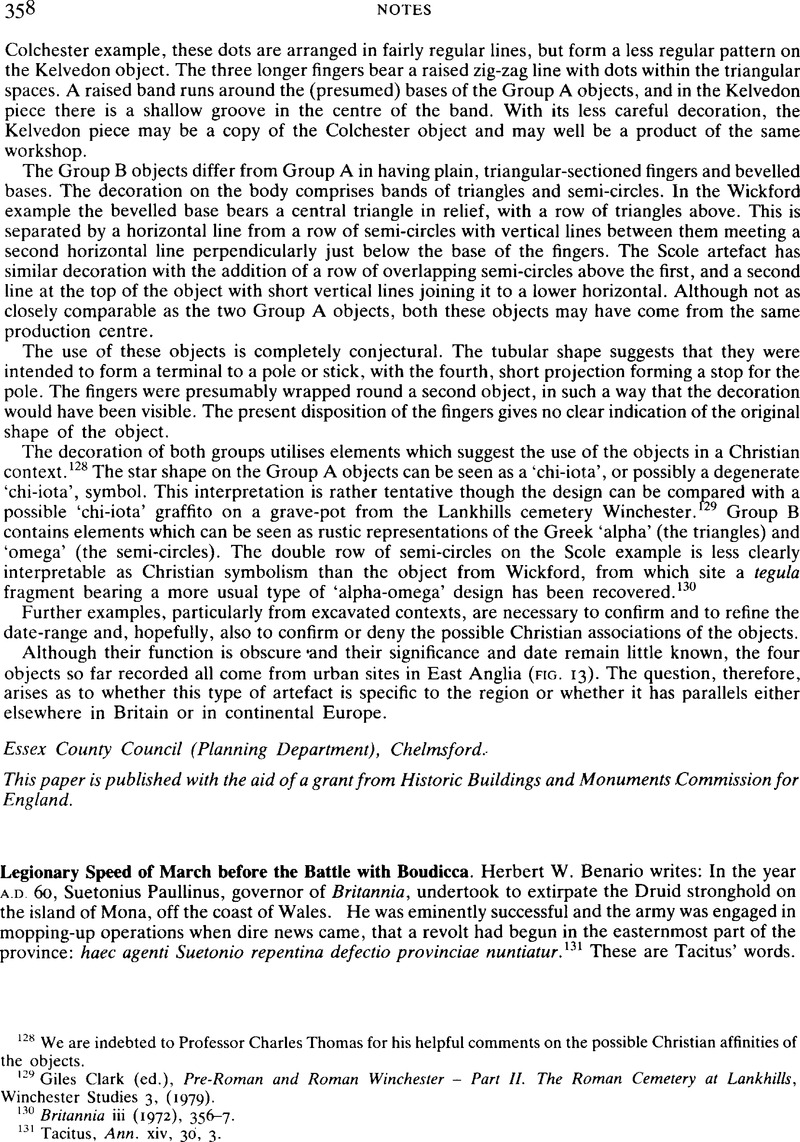Published online by Cambridge University Press: 09 November 2011

131 Tacitus, Ann. xiv, 30, 3.
132 xiv, 33, I
133 xiv, 34, I
134 Römische Geschichte2 V (1885), 165 n.I: ‘Eine schlechtere Relation als die des Tacitus über diesen Krieg 14, 31–39 ist selbst bei diesem unmilitärischten Schriftsteller kaum aufzufinden. Wo die Truppen standen und wo die Schlachten geliefert wurden, hören wir nicht, dafür aber von Zeichen und Wundern genug und leere Worte zuviel.’
135 lxii, 8, I ό δἑ пαυλινοζ ετυχε μἑν ἤδη τἡν Μωνναν παραστηάμενοζ, πυθόμενοζ δἑ τἡν BρεττανιKἡν συμφοάράν ἀπἑπλενσεν εὐΘὐζ ἐζ αὐτᾐν ἐχ τὠζ Μὠννηζ.
136 See Bardon, H., La Littérature Latine Inconnue II (1956), 172–73.Google Scholar
137 Pliny, NH ii, 187; the distance is short, and should rather be about 295 m.p. A.L.F. Rivet & C. Smith, The Place-Names of Roman Britain (1979), give the approximate true distance from Londinium to Camulodunum as 55 m.p. and to Deva as 180 m.p. (119) and from Caernarvon to Deva as 76 m.p. (172). We may estimate some 60 m.p. from the crossing to Mona to Deva. The Roman mile measured 1,480 metres = 1,618 yards, hence 92% of an English mile. König, R. & Winkler, G., C. Plinii Secundi Nat. Hist. II (1974), 241,Google Scholar claim that Pliny's ‘200 000 Schritte = 296 km. Die tatsächliche Entfernung ist etwas grosser, etwa 370 km.’ Anglesey is some 250 miles from London.
138 Boudka (1978), 93, 95.
139 ibid., 90.
140 The Rebellion of Boudicca (1962), 63.
141 Tacitus, Agr. 16, 2.
142 Epit. rei militaris i, 9.
143 BC iii, 76, 1–3.
144 The figure which regularly appears in texts of the BC is VIII. That will not do; as Karl Nipperdey pointed out many years ago, in his commentary on Tacitus Ann. (1884), to xv, 16, 3, ‘ebenda ist in den Worten duplicatoque… procedit die lächerlich geringe Zahl, welche überdies in offenbarem Widerspruch mit dem Vorhergehenden steht, in XVIII zu ändern.’;
145 Veith, G. in Kromayer, J. & Veith, G., Heerwesen und Kriegführung der Griechen und Römer (1928), 353–55Google Scholar, is much too conservative. He speaks of 20 km as a iustum iter. Riepl, W., Das Nachrichtenwesen des Altertums mitbesonderer Rücksicht auf die Römer (1913), 129–36Google Scholar, is more generous, using Vegetius'; figures as a norm. Riepl gives numerous examples of extraordinary march achievements, both in speed and length, for the Republican period and the Hellenistic, but is totally silent about the Principate.
146 Cicero, ad Att. xvi, 10, 1: aiunt enim eum Caesarina uti celeritate. Caesar reports in BG vii, 40–41 that four legions without packs marched fifty miles within twenty-four hours, with a break of three hours.
147 Livy, xxvii, 44–50; Riepl, op. cit. (note 145), 131.
148 Livy, xxviii, 9, 12.
149 Wellesley, K., The Long Year A.D. 60 (1975), 196Google Scholar ; ‘covering in some twelve hours the thirty-five miles or so to Grotta Rossa.’
150 See A. Gerber & A. Greef, Lexicon Taciteum s.v.
151 See the sane remarks of Wellesley, K. in Dorey, T., Tacitus (1969), 64–65.Google Scholar
152 Wellesley, K., Cornelius Tacitus The Histories Book III (1972), vii.Google Scholar
153 Tacitus, Agr. 10, 4: hanc oram novissimi maris tune prim?m Romana classis circumvecta insulam esse Britanniam adfirmavit.
154 The legionary pack had a maximum weight of 60–70 pounds; see Watson, G., The Roman Soldier (1969), 62–66.Google Scholar In an emergency march they would have carried minimum rations and left behind their entrenching tools and palisade stakes; the weight would have been steadily reduced as they consumed their rations.
155 Lest any reader scoff, I call attention to Neumann, C., Historia xx (1971), 196–98,Google Scholar who claims that 36 miles a day for eleven days is highly probable and 52 miles in one day by no means absurd during Alexander's pursuit of Darius.
156 op. cit. (note 145), 131–32.
157 Tacitus Agr. 23.